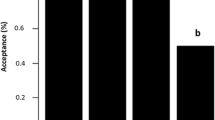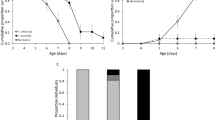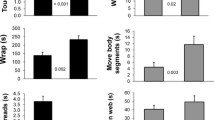Abstract
Prey-specialised spiders often do not have brood care and may not deposit eggs in the proximity of the preferred prey. Thus, naïve spiderlings are left to their own to find their focal prey. Our aim was to reveal whether the choice of a specific prey is innate and whether familiarisation with a certain prey will condition prey choice. We used the myrmecophagous spider Euryopis episinoides, which specialises on Messor ants. It finds ants using chemical cues deposited on the substrate. Naïve spiderlings were offered chemical cues from Messor and Myrmica ants and Drosophila flies. They chose significantly more chemical cues from Messor ants than those from Drosophila flies. Then spiderlings were assigned to three prey treatments: fed with Messor ants only (optimal prey), fed with Myrmica ants only (suboptimal prey) or fed with Drosophila flies only (detrimental prey) until adulthood. Every 2 weeks, all spiders from all treatments were offered chemical cues from the three prey types and the frequency of choice and latency to assuming a posture were recorded. Experienced spiderlings preferred chemical cues from the prey in which they were raised. They suffered high mortality on Drosophila flies and attained largest size on the optimal prey. We show here that majority of spiderlings are born with an innate preference to their focal prey, which can be altered by familiarisation with alternative prey, irrespective of whether such a prey is beneficial.



Similar content being viewed by others
References
Allan RA, Elgar MA, Capon RJ (1996) Exploitation of an ant chemical alarm signal by the zodariid spider Habronestes bradleyi Walckenaer. Proc R Soc Lond B 263:69–73
Barnes MC, Persons MH, Rypstra AL (2002) The effect of predator chemical cue age on antipredator behaviour in the wolf spider Pardosa milvina (Araneae: Lycosidae). J Insect Behav 15(2):269–281
Bateson P (2000) What must be known in order to understand imprinting? In: Heyes CB, Huber L (eds) The Evolution of Cognition. MIT Press, Cambridge, pp 95–102
Bernays EA (2001) Neural limitations in phytophagous insects: implications for diet breadth and evolution of host affiliation. Annu Rev Entomol 46:703–727
Bernays EA, Wcislo WT (1994) Sensory capabilities, information processing, and resource specialization. Q Rev Biol 69:187–204
Bolhuis JJ, Bateson P (1990) The importance of being first: a primary effect in filial imprinting. Anim Behav 40:472–483
Burghardt GM, Hess EH (1966) Food imprinting in the snapping turtle, Chelydra serpentine. Science 151:108–109
Carico JE (1978) Predatory behaviour in Euryopis funebris (Hentz) (Araneae: Theridiidae) and the evolutionary significance of web reduction. Symp Zool Soc Lond 42:51–58
Clark RJ, Jackson RR, Cutler B (2000) Chemical cues from ants influence predatory behavior in Habrocestum pulex, an ant-eating jumping spider (Araneae, Salticidae). J Arachnol 28:309–318
Cronbach LJ (1951) Coefficient alpha and the internal structure of tests. Psychometrika 16(3):297–334
Darmaillacq A-S, Chichery R, Shashar N, Dickel L (2006) Early familiarization overrides innate prey preference in newly hatched Sepia officinalis cuttlefish. Anim Behav 71:511–514
Dukas R, Kamil AC (2001) Limited attention: the constraint underlying search image. Behav Ecol 12(2):192–199
Ferran A, Dixon AFG (1993) Foraging behaviour of ladybird larvae (Coleoptera: Coccinelidae). Eur J Entomol 90:383–402
Gehlbach FR, Watkins JF II, Kroll JC (1971) Pheromone trail-following studies of typhlopid, leptotyphlopid, and colubrid snakes. Behaviour 40:282–294
Giurfa M, Núňez J, Chittka L, Menzel R (1995) Colour preferences of flower-naive honeybees. J Comp Physiol A177:247–259
Guibe M, Poirel N, Houde O, Dickel L (2012) Food imprinting and visual generalization in embryos and newly hatched cuttlefish, Sepia officinalis. Anim Behav 84:213–217
Hauge MS, Nielsen FH, Toft S (1998) The influence of three cereal aphid species and mixed diet on larval survival, development and adult weight of Coccinella septempunctata. Entomol Exp Appl 89(3):319–322
Jackson RR, Cross FR (2011) Spider cognition. Adv Insect Physiol 41:115–174
Jackson RR, Clark RJ, Harland DP (2002) Behavioural and cognitive influence of kairomones on an araneophagic jumping spider. Behaviour 139:749–775
Li D, Jackson RR (1997) Influence of diet on survivorship and growth in Portia fimbriata, an araneophagic jumping spider (Araneae: Salticidae). Can J Zool 75:1652–1658
Mayntz D, Raubenheimer D, Salomon M, Toft S, Simpson SJ (2005) Nutrient-specific foraging in invertebrate predators. Science 307:111–113
Neradilová M (2013) Trophic niche of myrmecophagous spiders. Bachelor thesis. Masaryk University, Brno. [in Czech]
Pekár S, Brabec M (2012) Modern analysis of biological data. 2. Linear Models with Correlations in R. Masaryk University Press, Brno. [in Czech]
Pekár S, Král J (2001) A comparative study of the biology and karyotypes of two central European zodariid spiders (Araneae, Zodariidae). J Arachnol 29(3):345–353
Pekár S, Toft S (2009) Can ant-eating Zodarion spiders (Araneae: Zodariidae) develop on a diet optimal for polyphagous predators? Physiol Entomol 34(2):195–201
Pekár S, Toft S, Hrušková M, Mayntz D (2008) Dietary and prey-capture adaptations by which Zodarion germanicum, an ant-eating spider (Araneae: Zodariidae), specialises on the Formicinae. Naturwissenschaften 95(3):233–239
Persons MH, Rypstra AL (2000) Preference for chemical cues associated with recent prey in the wolf spider Hogna helluo (Araneae: Lycosidae). Ethology 106:27–35
Porter SD, Eastmond DA (1982) Euryopis coki (Theridiidae), a spider that preys on Pogonomyrmex ants. J Arachnol 10:275–277
Powell W, Wright AF (1991) The influence of host food plants on host recognition by four aphidiine parasitoids. Bull Entomol Res 81(4):449–453
Punzo F (2002) Food imprinting and subsequent prey preference in the lynx spider, Oxyopes salticus (Araneae: Oxyopidae). Behav Process 58:177–181
R Core Team (2013) R: a language and environment for statistical computing. R Foundation for Statistical Computing, Vienna
Schausberger P, Walzer A, Hoffmann D, Rahmani H (2010) Food imprinting revisited: early learning in foraging predatory mites. Behaviour 147:883–897
Storeck A, Poppy GM, Van Emden HF, Powell W (2000) The role of plant chemical cues in determining host preference in the generalist aphid parasitoid Aphidius colemani. Entomol Exp Appl 17:297–304
Therneau T, Lumley T (2006) Survival: survival analysis, including penalised likelihood. R package version 2.29
Thompson JN (1988) Evolutionary ecology of the relationship between preference and performance of offspring in phytophagus insects. Entomol Exp Appl 47:3–14
Toft S (1999) Prey choice and spider fitness. J Arachnol 27:301–307
Van Emden HF, Storeck AP, Douloumpaka S, Eleftherianos I, Poppy GM, Powell W (2008) Plant chemistry and aphid parasitoids (Hymenoptera: Braconidae): imprinting and memory. Eur J Entomol 105:477–483
World Spider Catalog (2014) World Spider Catalog. Natural History Museum Bern. Online at http://wsc.nmbe.ch, version 15.5, accessed on 25.9.2014
Yan J, Fine J (2004) Estimating equations for association structures. Stat Med 23:859–874
Acknowledgments
We would like to thank the three anonymous reviewers for the useful comments. This work was supported by the programme “Employment of newly graduated doctors of science for scientific excellence” (CZ.1.07/2.3.00/30.009) co-financed from the European Social Fund and the state budget of the Czech Republic.
Author information
Authors and Affiliations
Corresponding author
Additional information
Communicated by: Sven Thatje
Rights and permissions
About this article
Cite this article
Pekár, S., Cárdenas, M. Innate prey preference overridden by familiarisation with detrimental prey in a specialised myrmecophagous predator. Sci Nat 102, 8 (2015). https://doi.org/10.1007/s00114-015-1257-8
Received:
Revised:
Accepted:
Published:
DOI: https://doi.org/10.1007/s00114-015-1257-8




